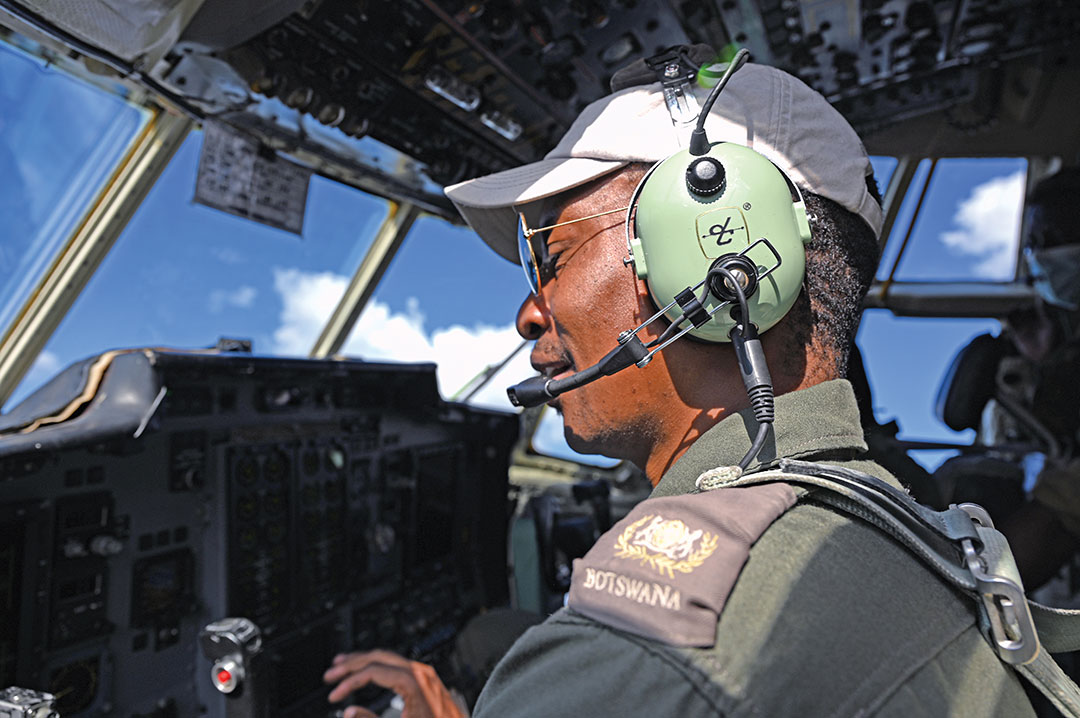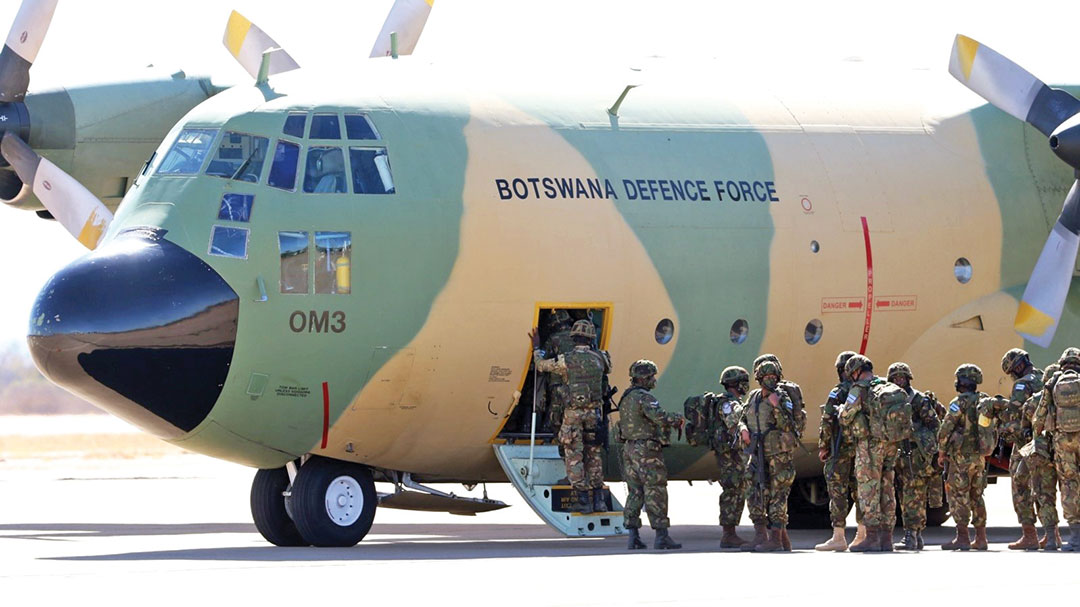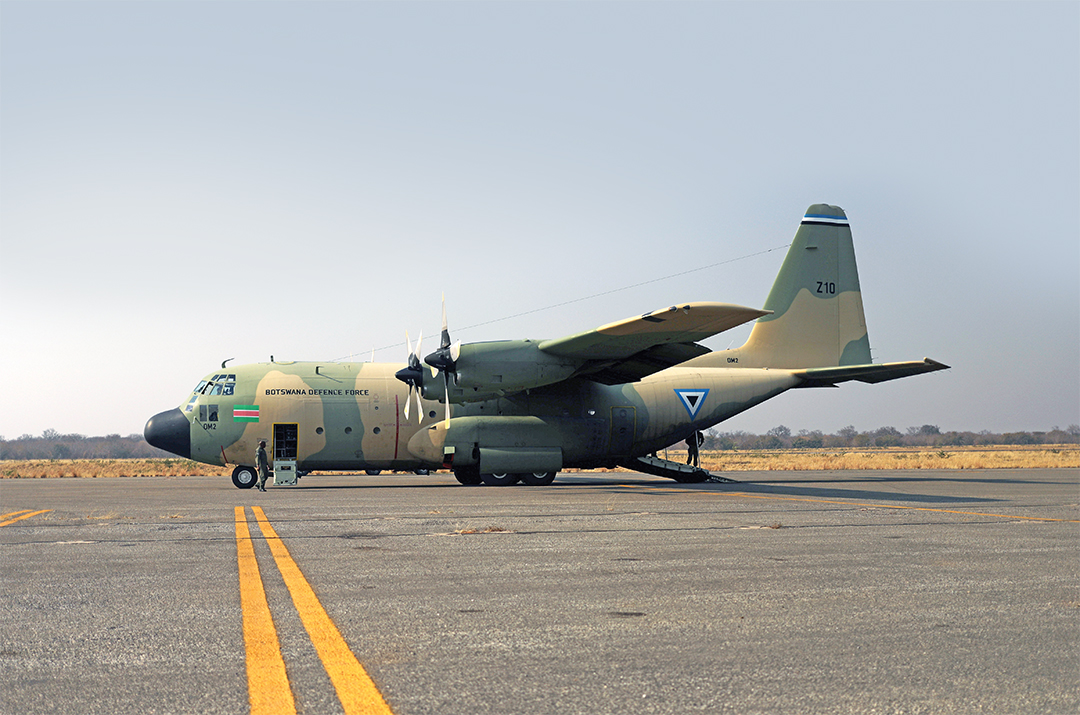‘We Know the Importance of Having Secure Skies’
Maj. Gen. Hendrick Thuthu Rakgantswana of Botswana Discusses Obstacles to Strategic Airlift, Maintenance and Technology
 Maj. Gen. Hendrick Thuthu Rakgantswana became chief of Botswana’s Air Arm Command in 2021 after serving in the Air Force since 1986. Rakgantswana has served as squadron commander of the Fixed-Wing Air Mobility Squadron and has piloted the presidential jet. He also has been Air Force director of operations and base commander at Thebephatshwa Air Base, the Botswana Defence Force’s main air base, about 100 kilometers outside the capital, Gaborone. Rakgantswana spoke with ADF on February 28, 2023, the first day of the African Air Chiefs Symposium,
Maj. Gen. Hendrick Thuthu Rakgantswana became chief of Botswana’s Air Arm Command in 2021 after serving in the Air Force since 1986. Rakgantswana has served as squadron commander of the Fixed-Wing Air Mobility Squadron and has piloted the presidential jet. He also has been Air Force director of operations and base commander at Thebephatshwa Air Base, the Botswana Defence Force’s main air base, about 100 kilometers outside the capital, Gaborone. Rakgantswana spoke with ADF on February 28, 2023, the first day of the African Air Chiefs Symposium,
in Dakar, Senegal. His remarks have been edited for length and clarity.
ADF: What made you join the military?
RAKGANTSWANA: The love for it, but way back then, Botswana was faced with these incursions from South Africa. They were most of the time flying into Botswana in pursuit of what was termed to be terrorists then. They were doing these attacks, these attacks on the military bases, attacks on villages that are around, located somewhere around the borders. I come from one small village called Ramotswa, so it’s just a stone’s throw from the South African border. And these guys would be coming in and they’d be setting off these bombs, these grenades, so I saw people die — innocent lives. It’s that that made me really to go out there and defend my country against those aggressions.
ADF: More recently, Botswana has been notable for being at peace internally and at peace with its neighbors. So, what is the primary use and purpose of the air force in that context?
RAKGANTSWANA: Well, for starters we are facing our internal, transnational crimes, the poaching issue. This is where the air force is very, very critical, because over and above transporting troops to those areas, we also avail ISR [intelligence, surveillance and reconnaissance] capability. We check that those guys don’t come into the country undetected. And it indeed assures our ground personnel that they have good support in their operations. So just sustaining those operations toward anti-poaching is good for them. That is one of our primary roles. The other one is right now we are helping this country fight the terrorists in their country, and that is Mozambique. The air force is critical in sustaining that operation. That is called SADC Mission in Mozambique, or SAMIM. We are doing a lot of flights into Mozambique, sustaining operations, doing rotations of personnel.
The other ones that we are doing as well are the humanitarian relief operations. A country like Mozambique for instance every year without fail experiences floods. Most all the rivers in Southern Africa just dump their water into Mozambique before it goes into the ocean. That is a challenge, and our government will be putting our heads together and saying “let’s contribute toward relieving Mozambique.” That is where now the efforts come in, and our assets will be collecting the foodstuffs and taking it to Mozambique for distribution to other hard-to-reach areas.
We have extended our humanitarian aid to other neighboring countries. I think the furthest that we’ve been to so far is Congo-Brazzaville after there was some explosion of the ammo depot [in 2012]. We’ve been to Malawi, we’ve been to Zimbabwe, we’ve been to Mozambique during Cyclone Idai. That one crippled the whole of Southern Africa.

ADF: What are the primary air assets of Botswana’s air force?
RAKGANTSWANA: In the airlift, we have those fixed-wing transport aircraft, the Hercules C-130, the CASA 235 and the CASA 212. And then, we have the helicopters, small kinds like the “Squirrels,” the AS350, and then we have the Bell 412s. And then the other one is for presidential flights, and the trainers. We do our own training; the only time we have to outsource training is when we procure a new platform, and that is just to do the type of conversion. Thereafter we sustain ourselves because we train instructors in that platform.
Of course, the fighter capability we are working on improving. Right now, we have the F-5s that are proving to be very expensive to maintain because of issues of obsolescence, so we are looking at a possible replacement platform in that regard. And this is where we are still dealing with the political principles to see that we can get funding toward the platform that we have identified. We’re still window shopping in that regard. We haven’t really identified which one. And that will be determined by funding. The idea is that we should not lose capability, because we know the importance of having secure skies.
ADF: How big a problem is strategic airlift on the continent, and how does Botswana see its role in contributing to that continental capacity?
RAKGANTSWANA: That one is a challenge, and we as air chiefs know it. Maybe we are unable to solve this or to convince the political leadership about the problem that we are facing. You find that we engage in these operations, or they have expectations from us as air chiefs. They would be saying, “Do this thing,” not noting that they have not really resourced us to undertake that operation. What we see now is that we will be faced with this problem of having to airlift personnel, airlift consignment cargo, and we get stuck. Case in point: The SADC mission in Mozambique is proving to be difficult to sustain. And that is primarily because of the airlift mobility, or lack of airlift mobility. But as the South African Development Community, we have made pledges. One of the countries that has made pledges toward airlift is Angola, and of course Zambia. Zambia has offered the medium-lift transport aircraft. Angola has offered the heavy-lift transport aircraft. We just put our request now through SADC so that it ultimately finds its way to the Zambia force or Angola.
Then the challenge is the turnaround time. If I had that capability, obviously I would respond (snaps fingers) just like that. But now I have to rely on this country to deconflict its own operations from the one that I’m saying is a pressing matter on my side as well. I end up failing in that regard in terms of achieving what I want within reasonable time. What we are discussing at this summit is the importance of having that in place, and that, of course, in line with the African Peace and Security Architecture. It’s not like it’s going to be just a standalone entity. It is going to marry up on the existing structure of the African Union. It will be there with the African Union to identify where they need it, and then they are launched. What we are proposing is that it will be six platforms, and maybe the type of a C-130 and with everything else inclusive, including logistics, training, technical training, and obviously operations in terms of having pilots being able to operate those aircraft. It’s one huge capability that we should really aim to have.

ADF: One of the challenges facing African air forces is the ability to repair and maintain the platforms that they have. How big a challenge is maintenance, spare parts and repair for you as an air chief?
RAKGANTSWANA: It’s a huge challenge right now. The platforms that we are operating as a struggling economy is that we probably end up settling for something that is cheaper; it is probably old. We operate it for five, six years and then it’s due for heavy maintenance. We don’t have that capability. It’s due for component repair, and we will have to get those components from the OEM — original equipment manufacturer. And because it is old equipment they will be saying, “I can’t make this component, especially that you want just one of this component. Because it means resuscitating the factory that was shutting down. So, the minimum that I can avail to you is probably going to be 100 or so.” But then I think, “No, I don’t need 100. I just need one of those components.” The challenge now is looking for this component from different vendors. Sometimes it proves to be very difficult. At the end of it all, we don’t get that one; we end up now having to look within these other platforms that I have and saying, “OK, if I had three aircraft maybe that one I should use as a source of spares to support these two.” So, we will be stuck with these three aircraft that are not flying or one of those three flying and the other two are used to support this one so that we are able to sustain our operations.
But the other thing now of late is … especially the issue of costs. With this Russia-Ukraine war, we saw that the transport issue has gone up more than 10 times. In the past I used to ship some components to OEM like in the United States at less than $100,000 U.S. But right now, at the last I checked, it was about $800,000. You can see how much that is, and that is just one way. It’s just expensive, so much that we sit now with these components here; we sit with these aircraft here that are not doing anything for us.

ADF: With the challenges you’ve mentioned, how important is a symposium like the AACS in addressing these challenges for you, your neighbors and the whole of the continent?
RAKGANTSWANA: The AAFA, the Association of African Air Forces, wants to build or show the importance of cooperation, and that, as an individual country, you can’t have all that you need. And, therefore, look to the neighboring countries and see their capabilities, and say you as Angola you have this capability that I don’t have, so help me in terms of air mobility. You as a certain country, you can probably extend slots to me for training of technicians, so assist me in this regard. And for sure that is going to be a lot cheaper than me having to send these technicians to Europe or the U.S. We are now looking within ourselves and identifying the capabilities that we have so that all members now can benefit from those.
ADF: A lot of militaries, including those in Africa, are incorporating drones and unmanned aerial vehicles into their assets. Given that you work heavily in anti-poaching, has your Air Force considered incorporating drones?
RAKGANTSWANA: We have ISR platforms in which we are using fixed-wing aircraft, pilot-flown as compared to a drone … but it’s a good capability to have for sure, and we see the importance of this now in our operations out there in Mozambique, because you can imagine sending those guys out there but there are no eyes in the sky. In that case they just end up going into ambushes. That is the importance of drones; that is the importance of intelligence, surveillance and reconnaissance capability. We are shopping around for a drone type of ISR because the advantage of that one is that it can loiter for a long time — 24 hours, 18 hours — as compared to an aircraft that needs to come back to refuel after about five hours or so.


Comments are closed.